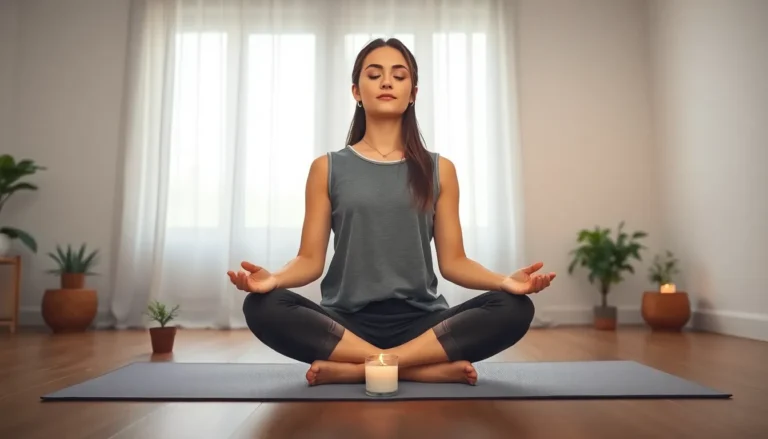Table of Contents
ToggleIn today’s fast-paced world, stress often feels like an unwelcome houseguest that just won’t leave. Between juggling work deadlines and managing personal lives, finding a moment of peace can seem impossible. But what if he told you that just a few minutes of mindfulness could transform chaos into calm?
Quick mindfulness activities aren’t just for yogis in fancy studios—they’re for everyone. Whether it’s a deep breath in the break room or a five-minute gratitude session in your car, these simple practices can help adults reclaim their sanity without the need for a meditation retreat in Bali. So grab a cup of coffee, take a deep breath, and let’s dive into some fun and effective ways to sprinkle mindfulness into the daily grind.
Understanding Mindfulness
Mindfulness involves maintaining a moment-to-moment awareness of thoughts, feelings, and surroundings. It allows individuals to engage fully with their experiences and promotes overall well-being.
Definition of Mindfulness
Mindfulness refers to the practice of being present and fully engaged in the current moment. It includes observing thoughts and feelings without judgment. Techniques like meditation and deep breathing can enhance mindfulness, helping individuals focus on their sensory experiences. This practice is rooted in ancient traditions but has gained popularity in modern psychology, offering practical applications for daily life.
Benefits of Practicing Mindfulness
Practicing mindfulness brings numerous benefits for mental and emotional health. Enhanced focus and concentration help individuals navigate daily challenges more effectively. Reduced stress levels contribute to better emotional regulation and resilience. Mindfulness also fosters self-awareness, allowing people to understand their thoughts and behaviors more deeply. Regular engagement in mindfulness activities can lead to improved relationships and greater overall life satisfaction.
Quick Mindfulness Activities for Adults

Quick mindfulness activities provide effective ways to reduce stress and promote well-being. Each activity can seamlessly fit into daily routines, making mindfulness accessible to everyone.
Breathing Exercises
Breathing exercises foster a sense of calm and focus. Practicing deep abdominal breathing engages the diaphragm, enhancing oxygen intake. Individuals can inhale deeply through their noses for a count of four, hold for a count of four, and exhale through the mouth for a count of six. Repeating this cycle for five minutes helps lower heart rates and reduces anxiety. Alternate nostril breathing offers another approach, balancing the body’s energy by inhaling and exhaling through one nostril at a time. These exercises encourage mindfulness by centering attention on breath patterns and sensations.
Grounding Techniques
Grounding techniques promote present-moment awareness. The 5-4-3-2-1 technique offers a simple way to reconnect with the environment. Individuals identify five things they see, four things they can touch, three sounds they hear, two scents they can smell, and one positive thing about themselves. This practice anchors thoughts in the present, reducing overwhelming feelings. Another effective method is body scan meditation, where individuals mentally check in with different body parts. Noticing sensations or tension helps cultivate awareness and brings focus away from stressors. These techniques empower individuals to regain control and find stability.
Mindfulness in Daily Life
Mindfulness can effortlessly blend into daily routines, enhancing focus and reducing stress. Quick practices are effective at home, work, or while on the move.
Integrating Mindfulness at Work
Integrating mindfulness at work cultivates a more focused environment. Taking short breaks every hour allows individuals to practice deep breathing, promoting relaxation and re-centering. Listening to calming sounds or guided meditations during lunch can boost mood and productivity. Utilizing mindful emails or messages, where individuals pause to reflect before responding, encourages thoughtful communication. Prioritizing self-care through brief mindfulness sessions, such as a five-minute mindful stretch, mitigates stress and fosters a harmonious atmosphere.
Mindfulness During Commutes
Mindfulness during commutes transforms travel time into meaningful moments. Engaging in focused breathing exercises calms the mind, making the journey more pleasant. Listening to mindfulness podcasts or calming music enhances relaxation. Observing the surroundings, such as noticing colors and shapes, grounds individuals in the present moment. When commutes utilize public transportation, practicing gratitude by reflecting on positive experiences during the day can shift focus from stress to appreciation, improving overall satisfaction.
Creating a Mindfulness Routine
Establishing a mindfulness routine fosters a consistent practice, enhancing overall well-being. Integrating mindfulness into everyday life requires thoughtful strategies.
Setting Realistic Goals
Setting realistic goals encourages sustainable mindfulness practices. Individuals can start with short sessions, such as five minutes of deep breathing or a brief gratitude exercise. Gradually increasing the duration and complexity of activities, such as incorporating short meditations or mindful walks, promotes growth without overwhelming oneself. Tracking progress through journaling reinforces commitment and provides motivation. Clear, achievable objectives create a sense of accomplishment and encourage individuals to develop a lasting mindfulness habit.
Finding the Right Environment
Finding the right environment enhances mindfulness practices. Individuals benefit from selecting quiet, comfortable spaces free from distractions. Creating a dedicated mindfulness area, whether at home, in an office, or outdoors, allows for deeper engagement. Incorporating calming elements, such as soft lighting, plants, or soothing sounds, enhances the experience. Flexibility in choosing locations enables individuals to practice mindfulness at various times, ensuring that even brief moments of stillness contribute to overall well-being.
Embracing quick mindfulness activities can significantly enhance daily life. These practices offer a simple yet effective way to manage stress and cultivate greater awareness. By integrating techniques like deep breathing and grounding exercises into routines, individuals can experience improved focus and emotional balance.
Mindfulness isn’t reserved for specific settings or lengthy sessions; it’s about finding those brief moments of stillness wherever possible. The key lies in consistency and the willingness to make mindfulness a part of everyday life. As individuals explore these accessible methods, they’ll likely discover a deeper sense of peace and fulfillment.




